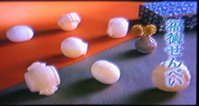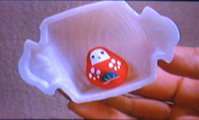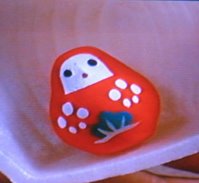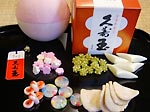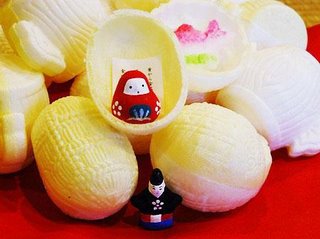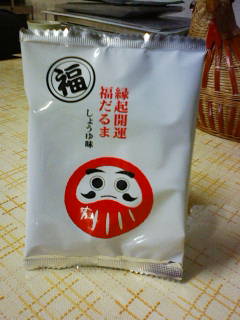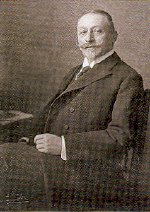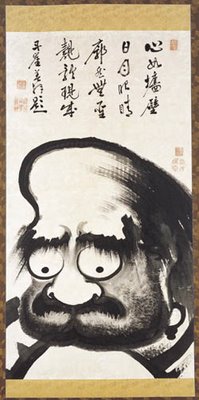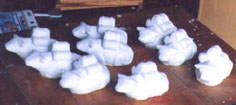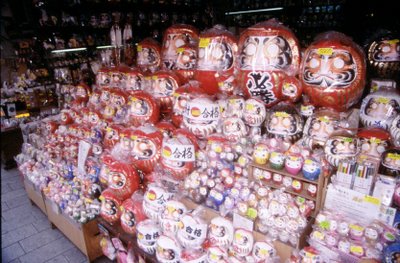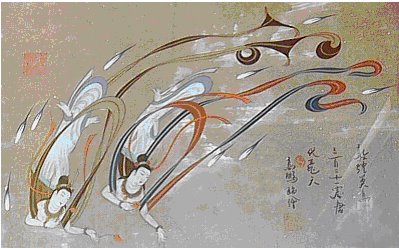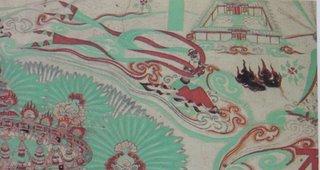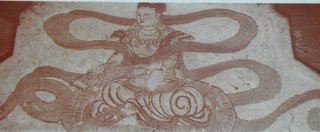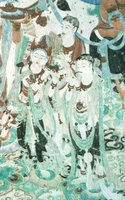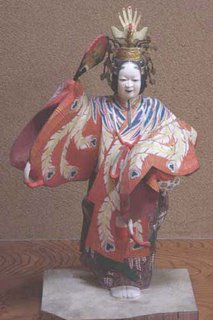[ . BACK to DARUMA MUSEUM TOP . ]
:::::::::::::::::::::::::::::::::::::::::::::::::::::::::::::::::::::::::::::::::::::::::::::::::::::
Yamashina Paintings 山科絵 Yamashina-e
Pictures from Yamashina and Otsu
山科絵 Yamashina-E and 大津絵 Otsu-E
I first met
Yamamoto san in October 2003 on a visit to the famous temple Daigo-Ji in Kyoto. He was sitting in a small stall, sourrounded by the most colorful and humorous pictures. Taking a good look, there was of course Daruma san among the featured subjects. On this picture below you can see his BENTEN, one of the seven deities of Good Luck, another frerquent topic of his pictures.
 Yoshio Yamamoto
Yoshio Yamamoto, 63, makes it his life-work to revive Yamashina Paintings.
山本さんは山科絵を自分のライフ・ワークにしています。
What exactly are Yamashina Paintings?
During the Edo period, there were many travellers on the old Tokaido road, from Kyoto to Edo and back to Kyoto. Each of the 53 postal towns on the way had its own speciality, mostly some local food. Yamashina, but even more so the nearby town of Otsu, were famous for some kind of funny paintings of religious origin (Otsu-E). Yamashina is now a modern suburb of Kyoto.
.......................................................................
Otsu Paintings 大津絵 Otsu-E

They have survived until today and we find these motives on postcards or ceramics of all kinds.
Japanese folk painting known as otsu-e, so named for the town of Otsu just to the east of Kyoto, along the Tokaido road, the principal route linking Edo and Kyoto. Shops hawking cheap souvenirs included open-air painting studios where block-printed folk subjects embellished with vivid ink washes were offered in unmounted hanging scroll format, or as simple sheets of paper, each with a single subject.
quote
In celebration of the Japanese New Year, the
Mingeikan (Japan Folk Crafts Museum) has organized a special exhibition entitled Otsu-e: Edo Period Popular Paintings, showcasing this traditional Japanese genre of painting from the Edo Period (1615-1868).
The name otsu-e is derived from the place where these paintings were sold, in and around the post town of Otsu, which lay on the Tokaido Road running between Edo (present day Tokyo) and Kyoto. Stands were set along the road to sell these paintings as souvenirs to passing travelers. Created by anonymous artists, the paintings were sold in great numbers for little money.
Some of the first otsu-e were created during the Kanei Era (1624-44) following the early Edo persecution of Japanese Christians. The artwork provided an inexpensive source of Buddhist art that could be displayed in the homes of commoners who feared retribution from the authorities, and needed proof of their devotion to Japanese religious beliefs.
By the end of the Genroku Era (1688-1704), otsu-e had become so popular that their themes were expanded to include depictions of secular subjects, such as beautiful women, courtesans, heroes, animals and mythical goblins.
Among the auspicious otsu-e motifs on display at the exhibition are depictions of the Shichifukujin, or Seven Deities of Good Luck. Displaying images of these deities was believed to be talismanic, bringing longevity, wealth and business success to their owners. The practice of displaying Shichifukujin originated in the 15th century. The deities were drawn from an eclectic mix of Buddhist, Shinto and Taoist figures.
The deities are often portrayed riding in a boat together, but some otsu-e portray one or two deities, which are popular to display during the New Year.
One such painting, "Daikoku Shaving Fukurokuju," demonstrates the happy and humorous natures of these two members of the group of Seven Deities. Daikoku is the deity of prosperity, while Fukurokuju is the deity of longevity. Daikoku is almost naked, clothed only in a loincloth and wearing a red hood. Holding a razor in his right hand, he must climb a ladder in order to shave Fukurokuju's head, since it is so elongated. The painting illustrates the human qualities of deities, who seem less than godlike in such poses, showing that the immortals have as many foibles as us ordinary folk.
This painting also demonstrates the exceedingly simple artistic techniques used to depict the subjects of otsu-e. Usually drawn on plain brown paper, the paintings utilize a limited number of mineral pigments, typically including the colors blue, red, green, yellow and white. The first stage in creating the paintings was to make an outline in black, which was then filled in with colors in simple brushwork.
Each member of an artist's family pitched in to help, including parents and children. This process assured the quick completion of each work and enabled mass production of art. Many local craftsmen were involved in the production process, resulting in a pool of local themes in otsu-e art. So cheap that almost anyone could afford them, the art was often attached to doorways or glued on pillars and sliding doors in commoners' homes.
MORE
source : www.mingeikan.or.jp
There is also a special museum for Otsu paintings in the Town of Otsu.
http://www.lbm.go.jp/kenhaku/shoukai/06.html
:::::::::::::::::::::::::::::::::::::::::::::::::::::::::::::::::::::::::::::::::::::::::::::::::::::
 . Shōmen Kongō 青面金剛 Shomen Kongo, .
. My Otsu Paintings 大津絵 .
with Daruma san and with O-Fudo san
and more
The ten most important subjects of Otsu-E
. Shōmen Kongō 青面金剛 Shomen Kongo, .
. My Otsu Paintings 大津絵 .
with Daruma san and with O-Fudo san
and more
The ten most important subjects of Otsu-E
大津絵十種
1. 鬼の寒念仏; 2. 鷹匠; 3. 寿老人; 4. 藤娘; 5. 矢の根五郎;
6. 瓢箪鯰; 7. 雷公の太鼓釣り; 8. 釣鐘弁慶; 9. 槍持奴; 10. 座頭; 11. 文読む女; 12. 猫と鼠
 and a song about Otsu-E
and a song about Otsu-E 大津絵節
げほうの 梯子剃り
雷太鼓で 釣瓶とる
お若衆は 鷹を持つ
塗笠お女郎がかたげた藤の花
座頭のふんどしを犬ワンワンつきや
びっくり仰天し 腹立ち杖をばふり上げる
荒気の鬼もほっきして 鉦しもく
瓢箪なまずを しっかとおさえます
奴さんの尻ふり行列
向ふ八巻釣鐘弁慶
矢の根男子
- source : otsue.jp/intro_busi.html -
.............................................................
Moriyama town 守山市
Ootsu-e juuninshuu dorei 大津絵十人衆人形土鈴
clay bells of 10 important themes from Otsu pictures
Made according to paintings by 高橋松山
Takahashi Shozan.

The 10 themes are
鬼の念仏 Oni no nenbutsu / 藤娘 Fuji Musume / 雷公 Raiko / 瓢箪鯰 Gourd and Catfish / 座頭 Zato / 槍持奴 Yakko with a spear / 鷹匠 falconer / 弁慶 Benkei / 矢の根五郎 Yanone Goro / 長寿翁 Choju Ogina
- 高橋松山 Takahashi Shozan - English Reference
born in 1932.

- Page with detailed photos of paintings and clay bells:
- reference : kyoudogangu.xii.jp/oumi -
. Shiga Prefecture Folk Art - 滋賀県 .
:::::::::::::::::::::::::::::::::::::::::::::::::::::::::::::::::::::::::::::::::::::::::::::::::::::
Concluding my remarks about Otsu-e:
They remind me a lot of HAIGA, I must say.
Maybe there is a link between them both after all?
Being painted by sort-of laypeople for common folk, not ment to be high art, but entertaining or used as presents from heart to heart.
Yamashina Paintings / My ALBUM
The BIG BROTHER of Otsu paintings is still very much alive, but
Yamashina paintings have been almost lost in our modern times.
Mr. Yamamoto, who lives in Yamashina, is trying to revive them in his own humorous style. He has done so after a lot of personal research and is now selling his paintings in various temples, since about 1998.
Many topics of these paintings concerned the gods of good luck and other deities of Shintoism and Buddhism, the same as we met above in the Otsu Paintings. They are painted with black ink and some watercolors, the faces of the gods are usually taken from the living men and women of his neighbourhood.
During the Edo period, these cheap paintings of the deities were all a poor traveler could afford during his trip, so Yamamoto san keeps his prices down too. After buying some of his postcards, he gave me a few more and later even sent me a long letter in beautiful calligraphy with a Daruma and some water goblins (kappa, picture 07 in my album). He wrote if Yamashina paintings would be made known outside Japan, that would be a great honour to him.
 Daruma san meets Sokrates,
Daruma san meets Sokrates, what a surprising combination of "East meets West". Yamamoto san was a schoolteacher before becoming a painter and a philosopher too.
だるまさんとソクラテス、なんと組むあわせ。西と東が仲良く話し合う。
 Two water goblins (kappa)
Two water goblins (kappa) hoisting a kite of Daruma in the air. Kappa is another speciality of his Yamashina paintings, but to explain about kappa here would get us too far off the subject. Just think of him as some kind of human-frog.
河童とだるま。河童は山科絵の特徴のひとつです。
03 Daruma toppled
This shows a Kappa looking at a Daruma doll which has tumbled over. The surprized face of the little Kappa is quite fascinating.
河童と起き上がりのだるま
04 naughty Kappa
Four naughty Kappa boys trying to tumble a Daruma, who in turn tries to hold steadfast, keeping his balance. The individual versus society, as Yamamoto smiles wisely.
4 匹の河童はだるまを倒そうとし、だるまはビックともしない。

Two postcards, each using a Chinese character associated whith a virtue of Daruma in a funny distortion. NINtai 忍耐, or steadfastness and koDOKU 孤独, to be alone.
漢字にだるまを書きました。忍耐、孤独 のだるま

Yamamoto san also gave me a larger square picture with 5 founders of religions :
"Kannon, Daruma, Shaka (Sakyamuni Buddha), Roshi (Laotsu),
and Koshi (Confucius).
 All my treasures of Yamashina paintings
All my treasures of Yamashina paintings mounted on the wall of the Daruma Museum. On the top line his letter with a sample of his individualistic calligraphy. Here Daruma is sourrounded by dancing water goblins.
だるま資料館に収まった山科絵のコーナー。
 . Kappapedia - My Kappa Blog .
. Kappapedia - My Kappa Blog .
:::::::::::::::::::::::::::::::::::::::::::::::::::::::::::::::::::::::::::::::::::::::::::::::::::
An abstract from a newpaper article about Yamamoto san in 2003.
京都新聞、2003年:
京都市山科区椥辻東浦町の画家、山本義雄さん(63)が江戸時代まで山科の旧東海道の街道沿いで売られていた「山科絵」を現代風に復活させた。同じルーツを持つ「大津絵」を参考に、京都の風景や山科ゆかりの人物などを描いており、「山科の名物にできれば」とはりきっている。
山科絵は、江戸時代の前-中期に生まれたとされ、半紙に神仏などの絵を描いて東海道を行き交う旅人に売られていた。東海道沿いでは、山科絵のほかに地元の名を付けた「大津絵」や「追分絵」「大谷絵」があったが、交通 の手段が徒歩から鉄路などに変わり、今では大津絵だけが残っている。
古い文献などで山科絵の存在を知った山本さんが、「地元の歴史を見直したい」と考え、山科絵と同様に仏画から生まれたとされる大津絵の技法を学び、独自の要素を入れて4年前に山科絵を興した。
山本さんの山科絵は、墨と顔料で描く大津絵を参考に、金閣寺や醍醐寺などの京都の社寺、小野小町など山科ゆかりの人物などを、現代の絵具も使って色彩 豊かに描いている。
「山科絵がどんなものだったかは残っていないので、大津より都に近い分、華やかさを取り入れるようにした」と山本さん。「街道沿いで売られた絵は、貧しい人たちの信仰の対象として生まれ、そこに庶民の遊び心が入ってきた経緯がある。復活させた山科絵も、人の心をなぐさめるような絵にして、昔のように山科の名物にしていきたい」としている。
Kyoto Shimbun 2003.04.15 News
References:
Choken-Ji and the Benten Picture:
http://homepage2.nifty.com/otsuri/english/eng_picture/photo/eng_chokenji.htm
The second from the bottom shows the small stall of Yamamoto san.
http://homepage2.nifty.com/otsuri/pictures/photo/chokenji/chok_sakura.htm
:::::::::::::::::::::::::::::::::::::::::::::::::::::::::::::::::::::::::::::::::::::::::::::::::::::::::::::::::::::::::::
. The 53 stations of the Tokaido Road 東海道 .
:::::::::::::::::::::::::::::::::::::::::::::::::::::::::::::::::::::::::::::::::::::::::::::::::::::::::::::::::::::::::::
. Kappapedia - My Kappa Blog .
 . PINTEREST - Kappa Gallery .
. PINTEREST - Kappa Gallery .
:::::::::::::::::::::::::::::::::::::::::::::::::::::::::::::::::::::::::::::::::::::::::::::::::::::::::::::::::::::::::::
[ . BACK to DARUMA MUSEUM TOP . ]
[ . BACK to WORLDKIGO . TOP . ]
:::::::::::::::::::::::::::::::::::::::::::::::::::::::::::::::::::::::::::::::::::::::::::::::::::::::::::::::::::::::::::

















